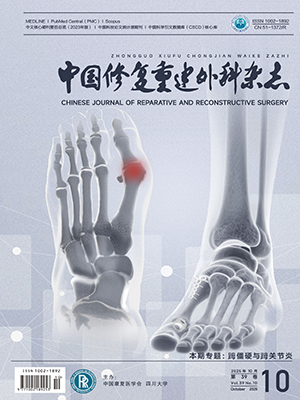Objective To investigate the effect of curcumin on calcitionin gene related peptide (CGRP) expression after spinal cord injury (SCI) in rats. Methods A total of 200 rats, weighing 250-300 g, were randomly divided into 4 groups (n=50): sham-operation group, normal saline (NS) group, low-dose curcumin group (30 mg/kg), and high-dose curcumin group (100 mg/kg). In sham-operation group, only vertebral lamina excision was performed without SCI; the SCI model was established in the other 3 groups. At immediate after modeling, 30 mg/kg and 100 mg/kg curcumin were injected intraperitoneally in 2 curcumin groups, equivalent NS was given in NS group (30 mg/kg), but no treatment in sham-operation group. At 1, 3, 7, 14, and 21 days after operation, the motor neural function was evaluated by the inclined plane test and Basso-Beattie-Bresnahan (BBB) scores; immunohistochemical staining and Western blot assay were used to observe CGRP expression. Results BBB score and inclined plane test score of NS group, low-dose curcumin group, and high-dose curcumin group were significantly lower than those of sham-operation group at each time point (P lt; 0.05). BBB score of low-dose curcumin group and high-dose curcumin group was significantly higher than that of NS group at 3, 7, 14, and 21 days after SCI (P lt; 0.05), and the score of high-dose group was significantly higher than that of low-dose curcumin group at 7, 14, and 21 days after SCI (P lt; 0.05). Inclined plane test score of low-dose curcumin group and high-dose curcumin group was significantly higher than that of NS group at 7, 14, and 21 days after SCI (P lt; 0.05), and the score of high-dose curcumin group was significantly higher than that of low-dose curcumin group at 7, 14, and 21 days after SCI (P lt; 0.05). Immunohistochemical staining results showed that the CGRP positive cells of sham-operation group was significantly more than those of the other 3 groups, and the CGRP positive cells of high-dose curcumin group were significantly more than those of low-dose curcumin group at each time point (P lt; 0.05); the CGRP positive cells of low- and high-dose curcumin groups were significantly more than those of NS group at 3, 7, 14, and 21 days after SCI (P lt; 0.05). Western blot assay results showed that the CGRP protein expressed at each time point after SCI in sham-operation group; the CGRP protein expression gradually decrease with time passing in NS group; but the CGRP protein expression gradually increased with time passing in low- and high-dose curcumin groups, and reached the peak at 14 days, then maintained a high level. Conclusion After SCI in rats, 30 mg/kg curcumin can improve rats’ motor function, and 100 mg/kg curcumin effect is more obvious, especially in promoting the expression of CGRP. That may be the mechanism of protection of the nervous system.
Citation: SUN Danhua,XU Jiwei.. EFFECT OF CURCUMIN ON CALCITIONIN GENE RELATED PEPTIDE EXPRESSION AFTER SPINAL CORD INJURY IN RATS. Chinese Journal of Reparative and Reconstructive Surgery, 2013, 27(10): 1225-1229. doi: 10.7507/1002-1892.20130268 Copy
Copyright © the editorial department of Chinese Journal of Reparative and Reconstructive Surgery of West China Medical Publisher. All rights reserved
-
Previous Article
TREATMENT OF THORACOLUMBAR KYPHOSIS CAUSED BY OLD FRACTURE USING PEDICAL SCREW AT THE FRACTURE LEVEL, INTERVERTEBRAL DISTRACTION, AND CAGE INSERTION BY POSTERIOR APPROACH -
Next Article
SHORT-TERM EFFECTIVENESS ANALYSIS OF THREE DIFFERENT TRICUSPID VALVE PLASTY FOR FUNCTIONAL TRICUSPID REGURGITATION




